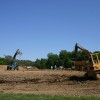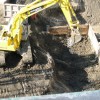Soils for Earthwork
Soils are made up of fragments of rocks and minerals as well as organics such as decayed plant material. Construction professionals use established soil classifications that help them define the type, size and distribution of soil particles in a representative sample at a project site. Prior to work, soil samples will often be taken and analyzed if a clear and comprehensive assessment of the site soils cannot be quickly determined. Classification allows for a sound understanding of a soil’s weight by volume, ability to support loads, permeability, cohesiveness and texture. These factors are not only critical to academic engineering concerns, but also represent time and cost considerations for earthwork, such as a potential need to remove existing soils and replace them with new ones, or concerns about construction equipment becoming mired in poor soils. Earthwork activities for a project might include clearing away debris and vegetation, grading of the project site to a level condition, excavations and embankments, and preparing roadway soils for pavement operations.
A distinguishing characteristic of soils to facilitate these activities is their gradation, or a percentage breakdown of a soil’s constituent particles by size and weight. A well-graded soil has a good distribution of different sized particles, whereas a poorly-graded soil does not. General categories of progressively smaller soil classification include stone; gravel; coarse, medium, and fine sands; silt; and clay. Gradation can be described by a percentage weight of these categories, or through a sieve analysis. A sieve analysis will grade the soil by its percentage passing through progressively smaller sieves. For example, a Number 4 sieve has a 4.76mm opening and would allow all soils to pass through it except larger stone and gravel pieces. A Number 200 sieve has a 0.074mm opening and will retain all but the smallest clay particles.
Several government and industry organizations concerned with soils have developed textural classification charts. These appear as a triangular graph with sand, silt and clay as the three indexes. Once a gradation has been completed on a soil, and the percentage of large particles such as stone and gravel has been subtracted out of the analysis, the remaining soils can be classified based on their sand-silt-clay composition. Soils containing a relatively even split of sand, silt, and clay are referred to as “loams”. If the sample contains more than 10% large particles (stone or gravel), that prefix is usually added to the description. For example, “gravelly sand” is one such soil description.
Significant implications for earthwork operations determined from these soil characterizations include: a greater clay percentage means more cohesive soil but lower strength to support loads; dry sand is good for foundations but poor for side slope stability during excavations; gravel with a well graded mixture of fine particles is potentially good for pavement base courses. Many other practical conclusions such as these can be drawn from proper soil classification.
Other professionals will have different focuses in their soils classification, beyond the soil type and gradation. For example, geologists may classify soils more upon their source of origin as being sedimentary, igneous, or metamorphic rocks.

Buildipedia Staff
The Buildipedia research and writing staff consists of dozens of experienced professionals from many sectors of the industry, including architects, designers, contractors, and engineers.
Website: buildipedia.com/





